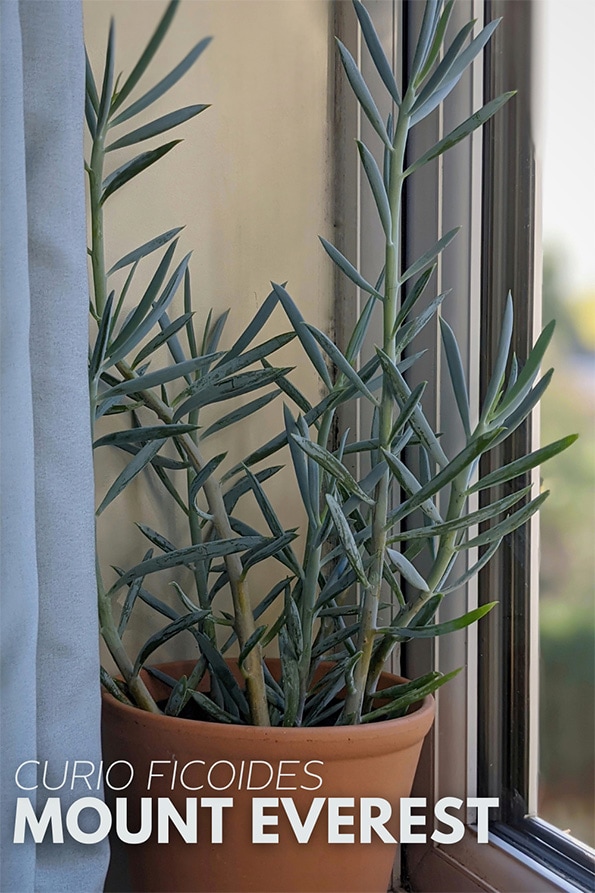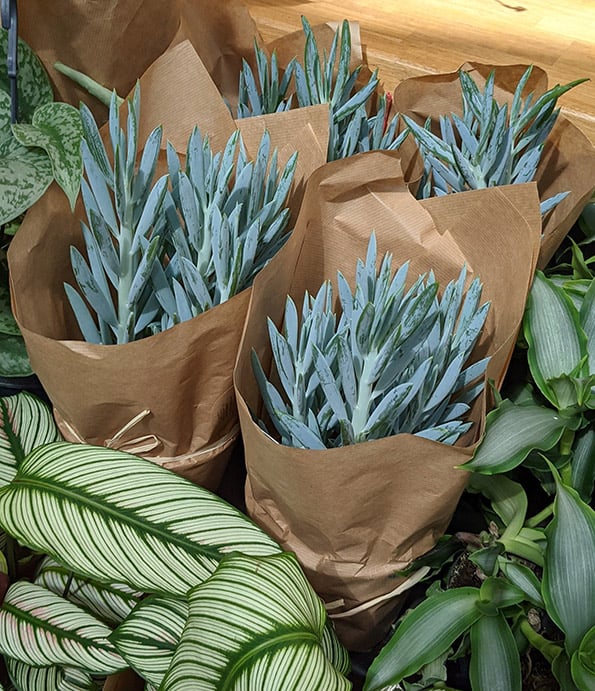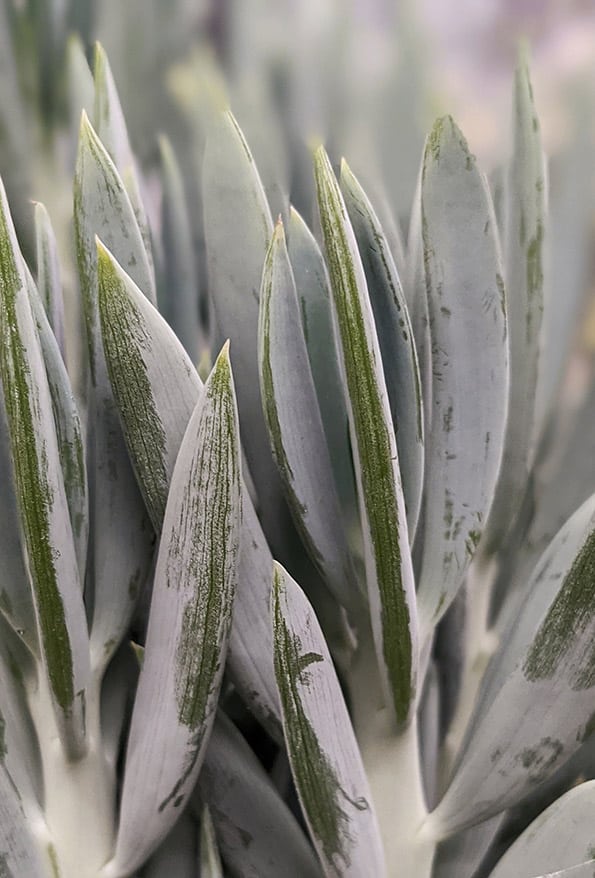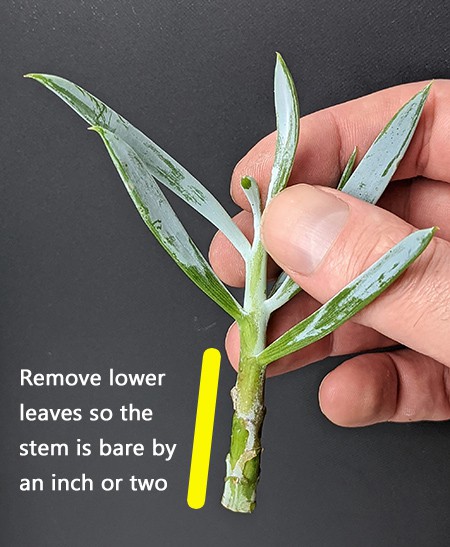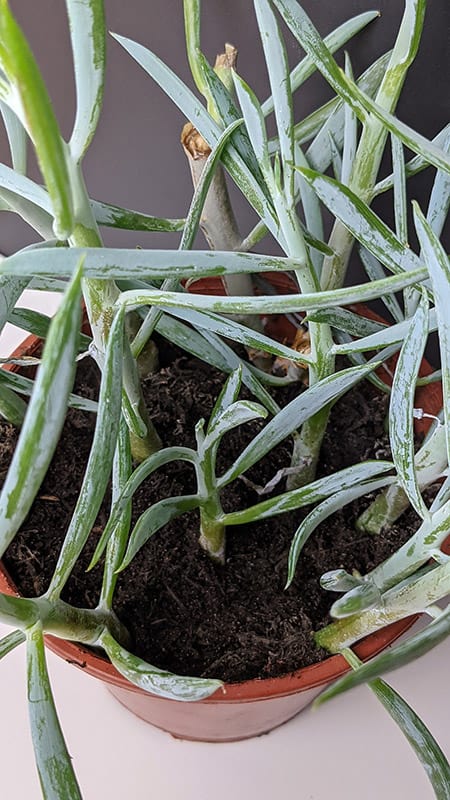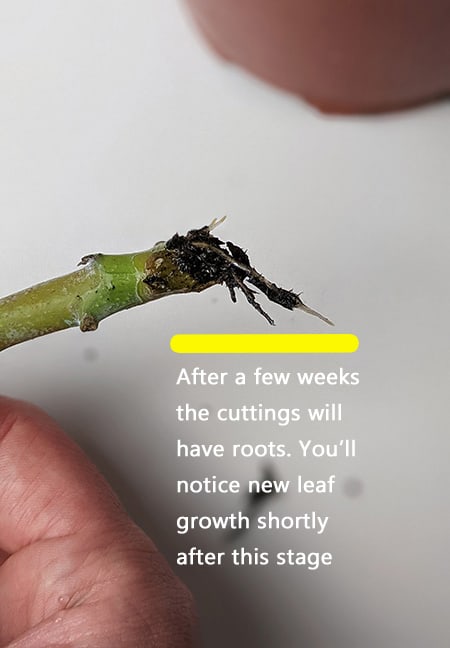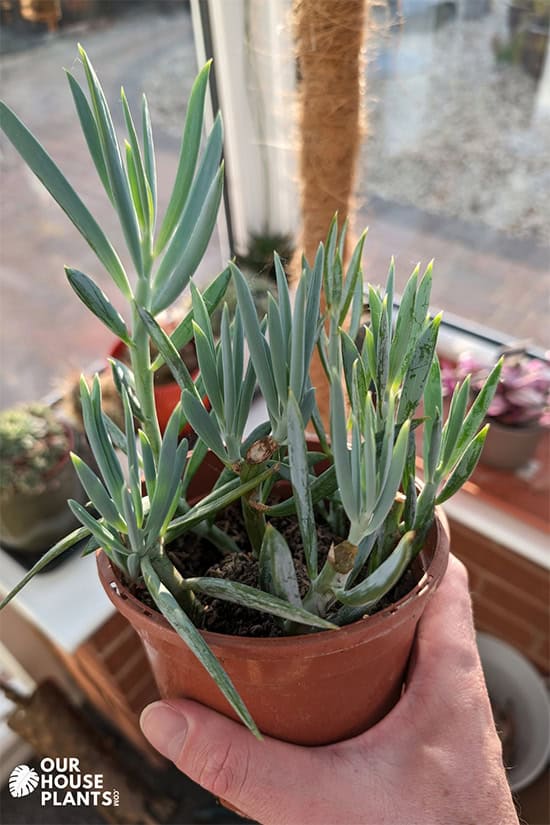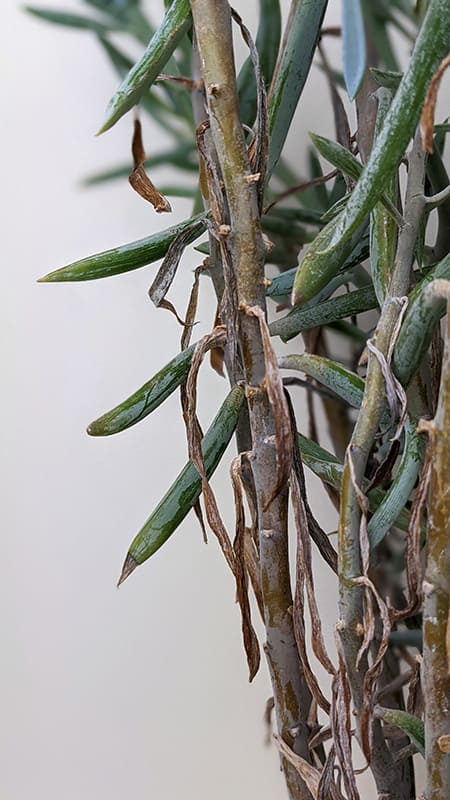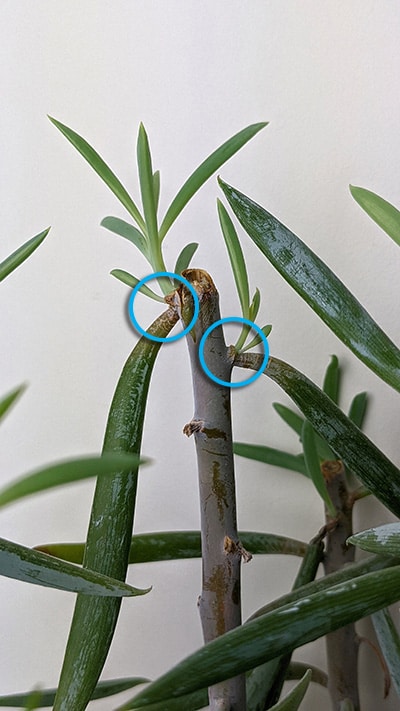If you like succulent plants, then Curio Ficoides 'Mount Everest' will probably put a smile on your face. It suits life as a houseplant very well and performs brilliantly if you can meet its basic care needs.
It goes by many common names, like Blue Chalksticks and Chalk Stick Succulent (more on this in a bit), but it's instantly recognizable to anyone familiar with the plant.
The gray, blue stems shoot upwards and hold themselves straight without any support, looking like a miniature Skyscraper (no surprise then that it also gets called the "Skyscraper Senecio").
Curio Ficoides 'Mount Everest' should be on your shortlist if you're after an attractive succulent plant and can provide it with some direct sunlight.
It's very easy going. A houseplant for beginners most definitely, but also different and unusual enough for seasoned plant parents to add it to their collection. Propagation has an almost 100% success rate if done correctly and it grows like crazy if placed in a bright position with some direct sun.
How do you pronounce Curio Ficoides correctly? Say:
Kyuor-ree-oh Fic-Oi-dis
Let's talk about the names. The scientific or Latin name first. The Senecio genus contains a lot of plants. However, in 1997 it was decided that species of Senecio, which had elongated, succulent leaves were sufficiently different that they needed to have their own genus.
So the Curio genus was created and around 20 plants previously in the Senecio genus were moved across. Including our "Mount Everest" here.
Top Tip
If the growth habit of your plant doesn't look like the ones in this article's photos, you may have a different species of Curio and not the "Mount Everest". The care needs are practically identical, so the instructions below should apply.
Unfortunately, many of these 20 plants look very similar and are easily confused. Quite a few are also sold as houseplants. There needs to be more clarity when it comes to sellers marketing them, but I'm not going to pull at that thread here.
So, in summary, it's normal to find these plants sold with various Latin names, including the old, outdated Senecio ones. Curio Ficoides is the plant shown in all the photos in this article.
You may see it sold as:
- Curio repens
(Senecio repens)
-
Curio serpens
(Senecio serpens)
-
Curio aquarine (Senecio aquarine)
-
Curio mandraliscae (senecio mandraliscae)
-
Curio crassulifolius (Senecio crassulifolius) and of course:
-
Curio ficoides 'Mount Everest' (Senecio ficoides 'Mount Everest')
Okay, moving on to the common names. This is more straightforward. Clearly, "Mount Everest" doesn't sound very Latin, and it's not. This is a trading name given by a nursery that chose to breed this plant in mass and then market and sell it as a houseplant.
It could also be listed or known by its other common names like:
- Skyscraper Senecio
-
Blue Senecios
-
Blue Chalksticks
- Blue Sticks
/ Blue Fingers
-
Chalkstick Succulent
All the common names derive from how the plant grows, looks, or feels. For example, they have thick fleshy leaves with a grayish and bluish mix of colors. The stick like stems and leaves are covered in a chalky material.
Although you may know it by a different name, after years of seeing this plant for sale, Mount Everest is the most frequently used, hence why I'm using it in my article.
They're not expensive houseplants to buy, nor are they considered rare. But you may still struggle to get hold of them, though, as they're not the most popular indoor plants going. Heading to a store with a wide range should increase the chances of finding it.
The Curio Ficoides care needs are quite straightforward, so one of these starter plants could easily be with you for the next decade or longer.
Anything more than $20 / L15 for a small, moderately sized plant is likely too much. Of course, if it's considered "rare" in your part of the world and you really want this plant, you may have to pay more.

Hi, I'm Tom!
If you're like me and enjoy the challenge of growing houseplants and getting them to thrive, then Ourhouseplants can help. This website shares my knowledge and years of growing plants and provides (hopefully) helpful advice on properly caring for your indoor plant friends.
They thrive in very bright light. A position in full sun will also be perfect for your Curio. They do struggle in anything that resembles medium or low light. I don't recommend trying to grow them like this, even for a few months. You're just going to get problems. Grow it in a sunny window (or the brightest window you have).
Mine is positioned in a south-west facing window and gets loads of light during the brightest and sunniest parts of the day. However, the parts growing at the back can still bend slightly towards the sun. It's easily resolved by rotating the pot every month or so.
Naturally Adapted to Droughts
Because they hold a lot of water, the leaves have a thick fleshiness about them. With prolonged underwatering, they will use up this water, and the leaves will start to look shriveled.
Most succulent plants growing in very bright light with an average sizes pot tend to be thirsty and Curio Mount Everest is no different here.
Because it's also usual to have multiple plants growing in the same pot, they can dry out extremely quickly. I water mine throughly and in the height of summer they've dried out fully within a few days. It might be another week before I remember to water them again.
For many other houseplants, this would be bad news, but Curio Mount Everest can cope with a drought like this for a week or two, so you don't need to be perfect with its watering needs. It's not optimal, though and it would be better if you could water within a day or two of the potting medium drying out.
On the flip side, you do need to be cautious not to give too much water too often; otherwise, you risk overwatering it. This is much more likely with very young small plants, those growing in a large container, or those not getting high levels of direct sun.
Underwatering is okay, overwatering will cause serious problems, so always waits until the potting mix has dried out, at least partly.
From my seven years or so of growing this plant, high or low humidity has never been an issue or caused any problems. They're adapted to dealing with variable conditions, so although the humidity level might encourage external issues like pests, it shouldn't directly affect the plant.
Curio plants often grow pretty fast, but the structure and growth of the plant are still relatively simple. They don't need vast amounts of feeding to do well. I will add a few drops of fertilizer to mine four or five times a year using a general houseplant purpose feed mixed and diluted in a watering can.
If you're keen to garden organically or avoid synthetic fertilizers, you can use one formulated from seaweed.
The waxy coating covers the upright stems and leaves, giving them the familiar gray-blue hue and that luxurious look.
This is an adaptable houseplant. Ideal growing conditions are between 17°C (62°F) and 25°C (77°F) (or higher). It will stop growing if temperatures get cooler, but providing you don't expose it to freezing temperatures it will be fine until things warm up again.
Keep it above freezing temperatures, though, because if any part of the plant freezes, you will seriously damage it.
Confession time. My main plant has been in the same plastic pot for seven years now. I've never repotted it!
This hasn't helped it. Over the years, some of the lower stems have become woody, the potting medium has broken down, and it struggles to hold water and nutrients.
Check the gallery above. The last two photos show the plant when I first got it and how it looked at the start of 2023 when I began putting this article together. You can see the difference. Some of that is natural aging, but some is down to my neglect.
TL:DR - My advice is to repot every three or four years.
I've not found them to be fussy with what potting mix you use, bar a few exceptions. I've propagated lots of these plants over the years (see the following section to learn how to do this) and had them growing in different mixes.
I've tried a gritty mix with extra perlite added to help with drainage (fine). I've used regular potting compost with coarse sand added (fine too). I've used regular potting soil with nothing added (also fine!).
I did try growing them in LECA and sphagnum moss, but both ended in failure. I also used some leftover chunky Aroid mix, but they didn't seem stable in this. It could be my bad luck, though. If you've had a different experience, I'd like to hear from you.
Did You Know?
Curio Ficoides is a succulent plant native to southern Africa that also does very well as an indoor plant.
The roots aren't excessively complex or strong, but they do need something that lets them anchor in and keep the visible part of the plant stable. A succulent or cactus mix should be good too, although I've not tried this. You could also use some peat free compost mixes providing the ingredients are finely shredded and not too chunky.
In my introduction, I mentioned the propagation rate was almost 100% and I stand by this. These plants are robust, and it's easy to create more.
The easiest way is to take stem cuttings and put them directly into a potting mix.
Attempts to do it by water propagation have been less effective for me, but you're welcome to try. I've also had little joy with leaf cuttings. They need a little bit of the main stem to be intact to get going properly.
To create brand new blue chalk succulents for your collection or to give away, you can cut off the top of the plants or use unwanted stems from any pruning you do.
All you need for the stem cuttings are a few inches from the top growth, as shown in the photo above. You can use longer stems, too; it all works!
Just make sure you remove any leaves around the bottom of the cutting. It's important that no leaves are buried and they don't "sit" on top of the potting mix as this can cause them to rot.
I don't use rooting hormone and I don't let the cut ends dry out and callous over for a couple of days. Literally, take the cuttings from the parent plant and then push them straight into the prepared potting mix, and away it goes.
Your potting mix (whatever you decide to use) should be similar to well-draining soil. Although water needs to be held by the mix, any excess should be able to come out of the drainage holes at the bottom. A moist (not soggy) mix is what your cuttings need to root.
It's then just a case of creating a small hole with the end of a pencil or finger and pushing the stem cutting in. Firm the potting soil around the end to keep it stable and in place until roots form. At this point, it will start to anchor itself. And that's all there is to it.
Some plants do not like being close or directly touching other plants, even if they're the same species. This isn't true for Curio Ficoides and the cuttings are perfectly happy to share the space. So if you're after a full looking plant, pack them in!
Rooting should be faster in the warm summer months, but I took cuttings for these photos in the cold months of December and January and they've rooted fine too.
Water the mix so it's moist, and then put the container with the cuttings in a warm, bright spot. It won't work if you put them somewhere cold or in a low-light location. However, avoid anywhere with intense sunlight until the cuttings are established, as this can cause them to dry out too fast.
A few weeks later and the roots should be growing. I've removed one of the cuttings for the photo above to show you what happens, but you don't need to do this; constantly digging out the cuttings and checking for roots can be damaging.
Instead, look for new growth on the stems, as soon as you see a new bud or leaf forming, you know it's worked and you have a new plant on the way.
Watch me propagation my own plant on YouTube
In the growing season, growth is quick if the conditions are warm and you give them enough light. I even spot slight growth (although it's slower) during mid-winter. I suspect this is because of the winter sunshine, and they're in my warm living spaces.
Curio Ficoides has a unique upright form and will grow upwards to several feet or more. Even though the stems are sturdy, they start to lean and wobble when they get taller which might not be ideal and your plant may need a little support to stay in place.
Whenever mine get out of hand and are too tall for their space, I give them a haircut by trimming the tops and propagate new plants with the cuttings (eases my guilt for doing it!).
They don't tend to bush out if left alone, but you can prune the stems to encourage side growth and a more "full" look.
One of my propagated Mount Everest plants that I've given to my mum.
None of my Mount Everest plants have ever flowered indoors. However the Curio genus is part of the Asteraceae family and the plants within this group do produce blooms. So in the right circumstances you could get small white flowers appearing. Here's a photo if you're curious about what they look like.
They're mildly toxic, although there are almost no reported cases of severe illness from people or animals eating them. Pets and people that do eat parts of the plant are likely to suffer the usual problems of eating something that doesn't agree with us, like being sick and feeling unwell.
Interestingly I do find the Blue Chalks tends to repel pets. If you ever get any of the chalky film from the leaves and stems on your hands you will notice it feels very tacky and has an odor. I suspect this is what keeps pets away.
It's usual to have multiple plants growing in the same pot. I find they "play nice" and don't tend to compete excessively with each other. However, resources will be in demand, meaning they can be thirsty and nutrient hungry plants.
If you only have one or two individual plants / stems in a pot, that's fine too. But do adjust your watering and feeding needs accordingly (most likely the plants will need less of both).
Chalky Residue on the leaves and stems.
Personally, I'm not fond of this stuff at all. While it's not offensive to my nose, it has a distinctive unpleasant smell. It also leaves a funny feeling on your hands which is very hard to wash off. It's not a "problem" with the plant and is a normal part of its growth.
So if you're like me and not a fan of coming into contact with the chalky substance on the leaves, then I recommend using gloves when handling the plant excessively, for example when you propagate it or cut it back.
Yellowing leaves / stems.
This is only going to happen if the plant has been overwatered over a fairly long period, or it's been exposed to cold temperatures.
Leaf Drop / Soggy leaves or stem.
Leaf drop is rare on this plant. You will lose the odd leaf, but it will hold on to its leaves for years at a time.
So if this is happening very quickly (over a few days) then it will be from overwatering. Make sure you're using well-drained soil and letting it dry out completely before you water your plant again. You may also have some root rot happening underground. If it's very bad, propagate replacement plants.
If you notice these problems developing slowly over a period of months, it's probably going to be caused by too little light (and perhaps a little overwatering mixed in as well).
Woody, tired looking stems.
This is perhaps more common than you might think and can really give the plant a "tired" worn out look.
They're low maintenance plants and only need a little care to do well, but over the years its easy for an indoor plant to start to look tired like this.
There are a two main reasons this can happen.
The good news is that you can rejuvenate your plant.
If you cut the stems back hard, I'm talking about leaving just perhaps 3 or 4 inches of growth at the base of the plant. What should happen is new fresh growth will sprout at a leaf node below the cut line. You often get just one new stem forming, but two or three are common in healthy plants.
In the photo below, you can see this in action. I cut the stems back around a month ago and already two replacement stems have started to grow. This will give the plant a bushier appearance too. If you prefer the single stem upright look, just remove the weaker growth point(s) and leave one to grow.
You could also use the material you've cut off to propagate new plants.
As well as bringing new life back to your plant, pruning like this can also promote denser, more branched and bushy growth.
Lanky stems, spindly growth.
The appeal of Curio Mount Everest is the elegant tall straight central growing stems. However, if the plant seems to be "reaching", the stems are leaning over or the stems have long sections between leaves, it could be a problem.
The most likely reason is lack of light, causing it to elongate and grow poorly. The obvious answer is to provide more light, ideally put it in a spot that gets at least a little partial sun. If the plant already looks quite bad, it might be worth pruning it back and following the steps outlined in the above problem.
Pests
In the almost 10 years of ownership I've had no pests other than a small incident of Scale Insects. I did have a problems with Fungus Gnats when propagating new plants, although this was due to the potting mix.
From my experience, when grown properly with decent care, pests are pretty rare on Curio Ficoides Mount Everest. Although, if your experience differs do get in touch or leave a comment below.
